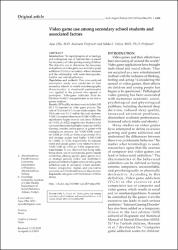| dc.contributor.author | Oflu, Ayşe | |
| dc.contributor.author | Yalçın, Sıdıka Songül | |
| dc.date.accessioned | 2021-05-05T22:14:13Z | |
| dc.date.available | 2021-05-05T22:14:13Z | |
| dc.date.issued | 2019 | |
| dc.identifier.issn | 0325-0075 | |
| dc.identifier.issn | 1668-3501 | |
| dc.identifier.uri | https://doi.org/10.5546/aap.2019.eng.e584 | |
| dc.identifier.uri | https://hdl.handle.net/20.500.12933/376 | |
| dc.description | YALCIN, SIDDIKA SONGUL/0000-0001-9061-4281; | en_US |
| dc.description | WOS:000499322000012 | en_US |
| dc.description | PubMed: 31758885 | en_US |
| dc.description.abstract | Introduction: The rapid progress of technology and widespread use of internet has increased the frequency of video gaming among children. The objective was to determine the frequency and patterns of video game use and video game addiction (VGA) in secondary school students and the relationship with socio-demographic, familial and individual factors. Population and methods: This cross-sectional descriptive study was conducted in four secondary schools in varied sociodemographic characteristics. A structured questionnaire was applied to the parents who agreed to participate. 'Videogame Addiction Scale for Children (VASC)' was performed to the videogamer students. Results: 297 healthy students were included; 245 (82.5 %) reported as video game players. The rate of VGA was 1.6 % in our whole sample. The VGA rate was 3.1 % within the male students. VASC-Geometric Mean Score (VASC-GMS) was significantly higher in male and obese children (p < 0.001, p=0.022, respectively). Students who use social media also had higher scores (p=0.034). Gaming consoles, online games or games with multiplayers increase the VASC-GMS scores (p=0.028, p=0.002, p=0.016, respectively). War and strategy games lead higher VASC-GMS (p < 0.001, p=0.034, respectively). In contrast, mind and casual games were related to lower VASC-GMS (p=0.006, p=0.004, respectively). Conclusions. It was observed that being male, being obese, use of social media, game console ownership, playing specific game geners (war or strategy games), online and multiplayer games are related to higher scores of video game addiction scale in secondary school students. Future prospective studies and preventive measures on VGA should focus on these factors. | en_US |
| dc.language.iso | eng | en_US |
| dc.publisher | Soc Argentina Pediatria | en_US |
| dc.rights | info:eu-repo/semantics/openAccess | en_US |
| dc.subject | video game | en_US |
| dc.subject | addictive behavior | en_US |
| dc.subject | children | en_US |
| dc.subject | obesity | en_US |
| dc.title | Video game use among secondary school students and associated factors | en_US |
| dc.type | article | en_US |
| dc.department | AFSÜ, Tıp Fakültesi, Dahili Tıp Bilimleri Bölümü, Çocuk Sağlığı ve Hastalıkları Ana Bilim Dalı | en_US |
| dc.contributor.institutionauthor | Oflu, Ayşe | |
| dc.identifier.doi | 10.5546/aap.2019.eng.e584 | |
| dc.identifier.volume | 117 | en_US |
| dc.identifier.issue | 6 | en_US |
| dc.identifier.startpage | E584 | en_US |
| dc.identifier.endpage | E591 | en_US |
| dc.relation.journal | Archivos Argentinos De Pediatria | en_US |
| dc.relation.publicationcategory | Makale - Uluslararası Hakemli Dergi - Kurum Öğretim Elemanı | en_US |
















